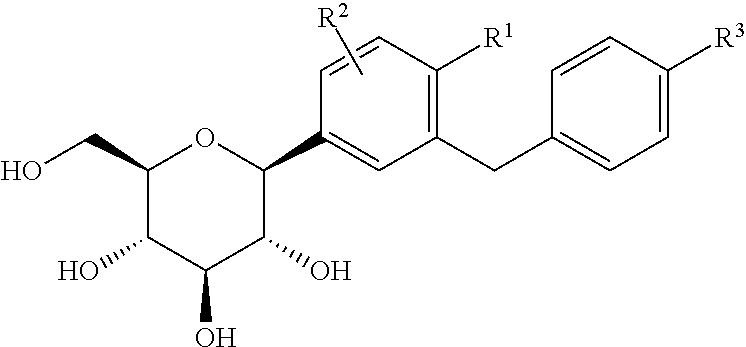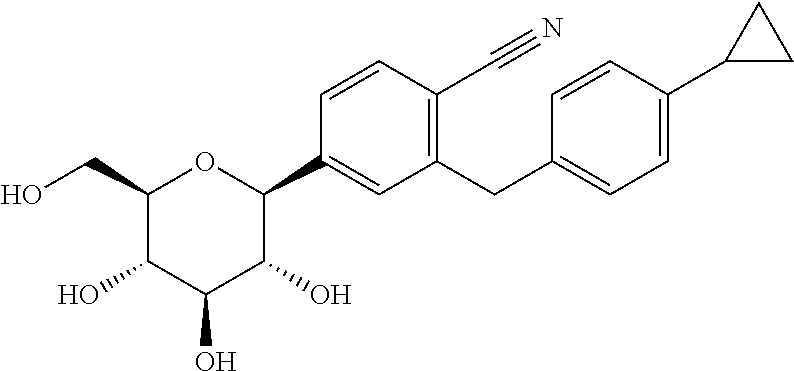Combination treatment of SGLT2 inhibitors and dopamine agonists for preventing metabolic disorders in equine animals
a technology of dopamine agonists and metabolic disorders, applied in the field of veterinary medicine, can solve the problems of poor understanding of the mechanism by which insulin resistance and/or hyperinsulinaemia cause ems and/or ppid, no satisfactory treatment currently available for metabolic disorders, and vascular dysfunction and/or laminitis in horses. improve insulin sensitivity and normalize insulin dysregulation
- Summary
- Abstract
- Description
- Claims
- Application Information
AI Technical Summary
Benefits of technology
Problems solved by technology
Method used
Image
Examples
example 1
The Effect of a Combination of One SGLT2 Inhibitor (Compound A) and One Dopamine Receptor Agonist (Compound B) on Postprandial Blood Glucose in Horses
[0271]The acute effect of a combination treatment with Compound A and Compound B on postprandial blood glucose in horses can be studied e.g. in overnight fasted horses. E.g. two hours after compound administration horses are fed a test meal and the postprandial glycaemia is quantified 2 hours thereafter. Values can be compared with the values before the start of the study and / or with those of a placebo group and / or the respective monotherapies with the one SGLT2 inhibitor and the one dopamine receptor agonist.
[0272]The efficacy of combination of SGLT2 inhibition and dopamine receptor agonism in accordance with the invention in the treatment of pathological fasting glucose and / or insulin and / or impaired glucose tolerance can be tested using clinical studies. In studies over a shorter or longer period (e.g. 2-4 weeks or 1-2 years) the su...
example 2
Effects of a Combination of One SGLT2 Inhibitor (Compound A) and One Dopamine Receptor Agonist (Compound B) on Equine Pituitary Pars Intermedia Dysfunction (PPID) and Associated Diseases Such as Insulin Resistance and / or Laminitis
[0273]Combination treatment with Compound A and Compound B can be studied in horses with metabolic disorders according to the present invention. Particularly in studies in horses with Equine Pituitary Pars Intermedia Dysfunction (PPID) and associated diseases such as laminitis running for different lengths of time (e.g. 2 weeks to 12 months or 2 to 3 years) e.g. the success of the improvement in insulin resistance can be checked using the measurement of baseline blood glucose, blood fructosamine and blood insulin level and their corresponding relation (surrogate indices) in the individual horse. Also the glucose and insulin values after a meal or after a loading test (glucose tolerance test or insulin tolerance test) after or during a period of therapy can ...
example 3
The Effect of a Combination of One SGLT2 Inhibitor (Compound A) and One Dopamine Receptor Agonist (Compound B) on Blood ACTH Level in Horses
[0275]The acute effect of a combination treatment with Compound A and Compound B on blood ACTH level in horses can be studied e.g. measuring basal blood samples of overnight fasted horses. Alternatively stimulation tests as described earlier can be employed.
[0276]Values can be compared with the values before the start of the study and / or with those of a placebo group and / or the respective monotherapies with Compound A or Compound B.
[0277]Particularly in studies in horses with Equine Pituitary Pars Intermedia Dysfunction (PPID) exhibiting elevated blood ACTH concentration running for different lengths of time (e.g. 2 weeks to 12 months or 2 to 3 years) e.g. the success of the improvement in insulin resistance can be assessed as described above.
[0278]Additionally, the effects of the combination treatment with Compound A and Compound B on blood ACT...
PUM
| Property | Measurement | Unit |
|---|---|---|
| mass | aaaaa | aaaaa |
| mass | aaaaa | aaaaa |
| concentrations | aaaaa | aaaaa |
Abstract
Description
Claims
Application Information
 Login to View More
Login to View More - R&D
- Intellectual Property
- Life Sciences
- Materials
- Tech Scout
- Unparalleled Data Quality
- Higher Quality Content
- 60% Fewer Hallucinations
Browse by: Latest US Patents, China's latest patents, Technical Efficacy Thesaurus, Application Domain, Technology Topic, Popular Technical Reports.
© 2025 PatSnap. All rights reserved.Legal|Privacy policy|Modern Slavery Act Transparency Statement|Sitemap|About US| Contact US: help@patsnap.com



